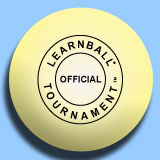Learnball® Facts
What is Learnball?
Learnball is a unique, motivational teamwork-management system. It improves student attendance, discipline, and schoolwork. The contest combines many commonly used classroom techniques to create a gestalt that lifts classroom morale. The gestalt includes, among other things, a simple sports format—toy-store hoop and foam ball—and very sophisticated psychological and sociological principles—consensus decision-making techniques and win-win point scoring—to create a novel learning environment. Learnball provides exciting team activity, while at the same time, preserves individual dignity and gives the teacher excelleny classroom control. Consequently, students who have a history of school failure and disruption become exemplary team members. Why? Learnball gives them coveted peer social approval when they behave properly. Similarly, students who have a history of success do even better for the same reason!
Kids Versus the Teacher
In a non-Learnball environment, students are automatically caught up in the game of Kids Vs. the Teacher (KVT). KVT is the classroom version of Kids Vs. the Older Generation. In the KVT contest, the teacher works to advance learning objectives, but the students do their best to block the teacher's moves. There are two major reasons why the rules of the student peer society dictate that students must not cooperate with the teacher.  First, there is the normal youthful desire to be independent, establish identity, and stand alone. This causes students to distance themselves from their elders—especially teachers and parents—and to resist adult directives. This tendency manifests itself in distinctive generational hairstyles, music, and clothing. Second, there is the natural youthful instinct to turn all activities into exciting play. Most non-Learnball classroom activities are dull by children's standards, so students create their own game of KVT to thwart the teacher's efforts. The daily Learnball contest, however, harnesses both of these youthful tendencies—resistance to adult authority and the need to play—so that those two powerful drives create a cooperative classroom environment. Learnball transforms the anti-teacher, peer-group norm into the Learnball good-sportsmanship code that mandates cooperation with the teacher. First, there is the normal youthful desire to be independent, establish identity, and stand alone. This causes students to distance themselves from their elders—especially teachers and parents—and to resist adult directives. This tendency manifests itself in distinctive generational hairstyles, music, and clothing. Second, there is the natural youthful instinct to turn all activities into exciting play. Most non-Learnball classroom activities are dull by children's standards, so students create their own game of KVT to thwart the teacher's efforts. The daily Learnball contest, however, harnesses both of these youthful tendencies—resistance to adult authority and the need to play—so that those two powerful drives create a cooperative classroom environment. Learnball transforms the anti-teacher, peer-group norm into the Learnball good-sportsmanship code that mandates cooperation with the teacher.
Lonely Little Boy
Learnball began with the school experiences of one lonely little boy—Earl Bradley. His father was a preacher who moved every two years to a new church in an era when most families never moved at all. Then during World War II, the preacher became an Army chaplain, and Earl, an only child, and his parents moved from one military post to another. Home for Earl during the war was sometimes a rented room in a boarding house, and he attended four or five schools a year! Because he was an only child and a preacher's kid, he entered all those new schools with a handicap. In addition, he was often lost in terms of understanding the lessons because the curriculum in the old school was different. Earl, therefore, often experienced the humiliation of being laughed at when he gave a wrong answer. But, when he finally caught on and began to demonstrate intelligence, his peers reacted negatively to that too. He more than once had to use his fists to defend himself against the class bully who worked to "initiate" the new smarty-pants kid.
Understanding Peer Power
Earl's movement in and out of many student groups gave him tremendous insight about peer protocol. That knowledge helped him do well in his first job—Air Force fighter pilot—and in his second job—teacher in an inner-city school. It also was key to his obtaining a Ph.D. from a major university where he wrote his dissertation on peer-group dynamics. The Learnball process evolved from Earl's doctoral work, and Learnball reflects his understanding of peer power.
Learnball Over Mindgames
As a public school teacher with a Ford Foundation grant, Earl wrote his doctoral dissertation about student teamwork. He drew from his childhood and military experiences to create what now is known as the Learnball process. He was delighted to find that Learnball held such a powerful attraction for youngsters that he didn't have to urge them to follow the rules or work hard; it was automatic. Youngsters supported their Learnball teams and did their best to follow the rules, to cooperate with Earl and with each other. They worked as hard as they could on their assignments because: (1) forming their own student teams made schoolwork a team objective, not an adult imperative, and (2) rivalry between their own teams was even more fun and more engaging than playing mind games with the teacher. Instead of being the adult who ordered and directed learning, Earl was a coach and facilitator who helped students conduct their own learning activities.
How Is Learnball Implemented?
Learnball is implemented by following steps in The Learnball Classroom Guide. Just as Dr. Bradley's childhood experiences formed the basis for Learnball's cooperative and supportive team strategies, his Air Force pilot training had a profound effect on The Learnball Classroom Guide. His flying experiences taught him the value of the step-by-step checklist used by pilots to guide them through the flight process. Dr. Bradley adopted that style for The Learnball Classroom Guide, and consequently, The Guide contains precise, fail-safe instructions for teachers and students. There are carefully worded speeches that are read aloud so that everyone does the right thing at the right time.
Precise as a Pilot's Flight Guide
While Bradley created The Guide years ago as part of his Doctor of Philosophy dissertation, he and his League colleagues have spent the years since patiently gathering suggestions from teachers using Learnball in every conceivable situation K-12. As a result, now The Learnball Classroom Guide is as precise as a pilot’s flight guide, effective for high-school seniors, but also simple enough for even primary-grade students to follow. No training is required because Learnball materials spell out exactly how to implement the process. As a result, Learnball can quickly increase motivation and discipline even under the most difficult conditions. Learnball is introduced to a faculty by distributing copies of these web pages (or contacting the League for complementary printed copies) to all faculty members and asking for volunteers to implement Learnball. Volunteers meet as a Learnball pilot group and select a Learnball coordinator who acts as liaison to the League.
  

|
|
First, there is the normal youthful desire to be independent, establish identity, and stand alone. This causes students to distance themselves from their elders—especially teachers and parents—and to resist adult directives. This tendency manifests itself in distinctive generational hairstyles, music, and clothing.














